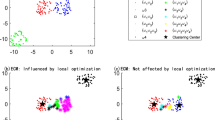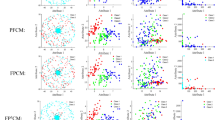Abstract
In this paper, we make an effort to overcome the sensitivity of traditional clustering algorithms to noisy data points (noise and outliers). A novel pruning method, in terms of information theory, is therefore proposed to phase out noisy points for robust data clustering. This approach identifies and prunes the noisy points based on the maximization of mutual information against input data distributions such that the resulting clusters are least affected by noise and outliers, where the degree of robustness is controlled through a separate parameter to make a trade-off between rejection of noisy points and optimal clustered data. The pruning approach is general, and it can improve the robustness of many existing traditional clustering methods. In particular, we apply the pruning approach to improve the robustness of fuzzy c-means clustering and its extensions, e.g., fuzzy c-spherical shells clustering and kernel-based fuzzy c-means clustering. As a result, we obtain three clustering algorithms that are the robust versions of the existing ones. The effectiveness of the proposed pruning approach is supported by experimental results.




Similar content being viewed by others
Notes
Most researchers assume that they can provide their clustering algorithms with a suitable initialization. Others use multiple (random) initializations that guarantee (with a given probability) that at least one initialization is good.
The average mutual information can be written in either of the two following forms [2]: \(I=\sum_{j=1}^l\sum_{k=1}^c {u_j u_{k|j}\log\frac{{u_{j|k}}}{{u_j}}}\) or \(I=\sum_{j=1}^l\sum_{k=1}^c {u_j u_{k|j}\log\frac{{u_{k|j}}}{{u_k}}}.\)
Please note the prior distribution u j is equal to \(\frac{{1}}{{l}}\) in the clustering procedure of traditional clustering algorithms, while it is used to phase out the noisy points in the proposed pruning method as discussed later in this section.
We run the four clustering algorithms on X12 with the same initial cluster centers ([−3.34, 1.67][1.67, 0.00]) as in [17]. It is observed that the result of FCM is nearly identical to that in [17]; however, the results of PCM and PFCM are a bit worse than those in [17]. For the purpose of fair comparison, the numerical results of PCM and PFCM in Table 1 are directly taken from [17], while the numerical results of FCM and RFCM are generated by our program.
References
Bezdek JC (1981) Pattern recognition with fuzzy objective function algorithms. Plenum Press, New York
Blahut RE (1972) Computation of channel capacity and rate-distortion functions. IEEE Trans Inform Theory 18(4):460–473
Blahut RE (1987) Principle and practice of information theory. Addison-Wesley, Massachusetts
Dave RN (1990) Fuzzy shell-clustering and applications to circle detection in digital images. Int J Gen Syst 16(4):343–355
Dave RN, Bhaswan K (1992) Adaptive fuzzy c-shells clustering and detection of ellipse. IEEE Trans Neural Netw 3(5):643–662
Dave RN, Krishnapuram R (1997) Robust clustering methods: a unified view. IEEE Trans Fuzzy Syst 5(2):270–293
Gath I, Geva AB (1989) Unsupervised optimal fuzzy clustering. IEEE Trans Pattern Anal Mach Intell 11(7):773–781
Girolami M (2002) Mercer kernel-based clustering in feature space. IEEE Trans Neural Netw 13(3):780–784
Cuillén A, Pomares H, Rojas I, Gonzélez J, Herrera LJ, Rojas F, Valenzuela O (2007) Studying possibility in a clustering algorithm for RBFNN design for function approximation. Neural Comput Appl 17(1):75–89
Gustafson EE, Kessel WC (1979) Fuzzy clustering with a fuzzy covariance matrix. In: Proceedings of the IEEE conference decision control. San Diego, CA, pp 761–766
Krishnapuram R, Nasraoui O, Frigui H (1992) The fuzzy c-spherical shells algorithm: a new approach. IEEE Trans Neural Netw 3(5):663–671
Krishnapuram R, Keller JM (1993) A possibilistic approach to clustering. IEEE Trans Fuzzy Syst 1(2):98–110
Krishnapuram R, Keller JM (1996) The possibilistic c-means algorithm: insights and recommendations. IEEE Trans Fuzzy Syst 4(3):385–393
MacQueen S (1967) Some methods for classification and analysis of multivariate observations. In: Proceedings of the fifth Berkeley symposium on mathematical statistics and probability, vol 1. University of California Press, pp 281–297
Man Y, Gath I (1994) Detection and separation of ring-shaped clusters using fuzzy clustering. IEEE Trans Pattern Anal Mach Intell 16(8):855–861
Müller KR, Mike S, Ratsch G, Tsuda K, Schölkopf B (2001) An introduction to kernel based learning algorithms. IEEE Trans Neural Netw 12(2):181–201
Pal NR, Pal K, Keller JM, Bezdek JC (2005) A possibilistic fuzzy c-means clusteirng algorithm. IEEE Trans Fuzzy Syst 13(4):517–530
Patané G, Russo M (2001) The enhanced LBG algorithm. Neural Netw 14(9):1219–1237
Rose K (1998) Deterministic annealing for clustering, compression, classification, regression, and related optimization problems. Proc IEEE 86(11):2210–2239
Schölkopf B, Smola AJ, Müller KR (1996) Nonlinear component analysis as a kernel eigenvalue problem. Technical report, Max Planck Institute for Biological Cybernetics, Tubingen, Germany
Selim SZ, Ismail MA (1984) K-means-type algorithms: a generalized convergence theorem and characterization of local optimality. IEEE Trans Pattern Anal Mach Intell 6(1):81–86
Song Q (2005) A robust information clustering algorithm. Neural Comput 17(12):2672–2698
Still S, Bialek W (2004) How many clusters? An information-theoretic perspective. Neural Comput 16:2483–2506
Yang XL, Song Q, Zhang WB (2006) A kernel-based deterministic annealing algorithm for data clustering. IEE Vis Image Signal Process 153(5):557–568
Yang XL, Song Q, Wang Y (2007) A weighted support vector machine for data classification. Int J Pattern Recogn Artif Intell 21(5):961–976
Zhang JS, Leung YW (2004) Improved possibilistic c-means clustering algorithms. IEEE Trans Fuzzy Syst 12(2):209–217
Acknowledgments
The authors sincerely thank the anonymous reviewers for their insightful comments and valuable suggestions on an earlier version of this paper.
Author information
Authors and Affiliations
Corresponding author
Rights and permissions
About this article
Cite this article
Yang, XL., Song, Q., Wu, YL. et al. A novel pruning approach for robust data clustering. Neural Comput & Applic 18, 759–768 (2009). https://doi.org/10.1007/s00521-009-0281-z
Received:
Accepted:
Published:
Issue Date:
DOI: https://doi.org/10.1007/s00521-009-0281-z




